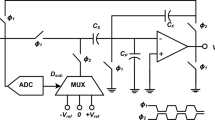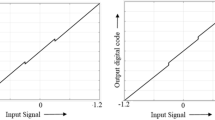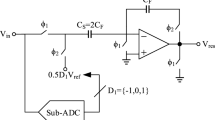Abstract
In this paper, a digital background calibration technique for pipelined analog-to-digital converters (ADCs) is presented to continuously mitigate the conversion errors arising from the residue amplifier imperfections. The introduced method indirectly measures the digitized residue errors based on a novel principle. In the proposed method, the digitized residue errors are measured through the probability distribution of the digitized residue and a two-level pseudorandom noise sequence. Behavioral simulations are provided for a 12-bit pipelined ADC architecture to show the effectiveness of the proposed technique. The simulation results show that the signal-to-noise and distortion ratio is improved from 42.94 to 72.85 dB using the presented calibration technique. The required number of samples for convergence is approximately 5 \(\times \) \(10^{6}\) clock cycles.















Similar content being viewed by others
References
I. Ahmed, J. Mulder, D.A. Johns, A low-power capacitive charge pump based pipelined ADC. IEEE J. Solid-State Circuits 45, 1016–1027 (2010)
L. Brooks, H.S. Lee, Background calibration of pipelined ADCs via decision boundary gap estimation. IEEE Trans. Circuits Syst. I Reg. Pap. 55, 2969–2979 (2008)
U. Eduri, F. Maloberti, Online calibration of a Nyquist-rate analog-to-digital converter using output code-density histograms. IEEE Trans. Circuits Syst. I Reg. Pap. 51, 15–24 (2004)
I. Galton, Digital cancellation of D/A converter noise in pipelined A/D converters. IEEE Trans. Circuits Syst. II Analog Digit. Signal Process. 47, 185–196 (2000)
J. Hu, N. Dolev, B. Murmann, A 9.4-bit, 50-MS/s, 1.44-mW pipelined ADC using dynamic source follower residue amplification. IEEE J. Solid-State Circuits 44, 1057–1066 (2009)
J.P. Keane, P.J. Hurst, S.H. Lewis, Background interstage gain calibration technique for pipelined ADCs. IEEE Trans. Circuits Syst. I Reg. Pap. 52, 32–43 (2005)
J.K. Kim, B. Murmann, A 12-b, 30-MS/s, 2.95-mW pipelined ADC using single-stage class-AB amplifiers and deterministic background calibration. IEEE J. Solid-State Circuits 47, 2141–2151 (2012)
B.C. Levy, A propagation analysis of residual distributions in pipeline ADCs. IEEE Trans. Circuits Syst. I Reg. Pap. 58, 2366–2376 (2011)
H.R. Mafi, R. Mohammadi, H. Shamsi, A statistics-based digital background calibration technique for pipelined ADCs. Integration 51, 149–157 (2015)
R.G. Massolini, G. Cesura, R. Castello, A fully digital fast convergence algorithm for nonlinearity correction in multistage ADC. IEEE Trans. Circuits Syst. II Exp. Briefs 53, 389–393 (2006)
B. Murmann, B.E. Boser, A 12-bit 75-MS/s pipelined ADC using open-loop residue amplification. IEEE J. Solid-State Circuits 38, 2040–2050 (2003)
B. Murmann, B.E. Boser, Digital domain measurement and cancellation of residue amplifier nonlinearity in pipelined ADCs. IEEE Trans. Instrum. Meas. 56, 2504–2514 (2007)
A. Panigada, I. Galton, Digital background correction of harmonic distortion in pipelined ADCs. IEEE Trans. Circuits Syst. I Reg. Pap. 53, 1885–1895 (2006)
A. Papoulis, S.U. Pillai, Probability, Random Variables, and Stochastic Processes, 4th edn. (McGraw-Hill, New York, 2002)
N. Rakuljic, I. Galton, Suppression of quantization-induced convergence error in pipelined ADCs with harmonic distortion correction. IEEE Trans. Circuits Syst. I Reg. Pap. 60, 593–602 (2013)
B. Sahoo, B. Razavi, A 10-b 1-GHz 33-mW CMOS ADC. IEEE J. Solid-State Circuits 48, 1442–1452 (2013)
B. Sahoo, B. Razavi, A 12-bit 200-MHz CMOS ADC. IEEE J. Solid-State Circuits 44, 2366–2380 (2009)
L. Shi, W. Zhao, J. Wu, Ch. Chen, Digital background calibration techniques for pipelined ADC based on comparator dithering. IEEE Trans. Circuits Syst. II Exp. Briefs 59, 239–243 (2012)
N. Sun, Exploiting process variation and noise in comparators to calibrate interstage gain nonlinearity in pipelined ADCs. IEEE Trans. Circuits Syst. I Reg. Pap. 59, 685–695 (2012)
B. Widrow, S.D. Stearns, Adaptive Signal Processing (Prentice-Hall, Englewood Cliffs, 1985)
B. Zeinali, T. Moosazadeh, M. Yavari, A. Rodriguez-Vazquez, Equalization-based digital background calibration technique for pipelined ADCs. IEEE Trans. Very Large Scale Integr. (VLSI) Syst. 22, 322–333 (2014)
Acknowledgments
The authors would like to thank Prof. Mahnaz Habibi and Prof. Hossein Shamsi for valuable discussions and useful suggestions.
Author information
Authors and Affiliations
Corresponding author
Appendices
Appendix 1
In this appendix, the transformation of a shifted CDF through the function \(g_{\mathrm{ad1}}(.)=g_{\mathrm{d1}}(g_{\mathrm{a1}}(.))\) is described. The relation between the input and output PDFs of the function \(g_{\mathrm{ad1}}(.)\) is given by
where \(p_{\mathrm{DR1}}(.)\) represents the digitized residue PDF and \(p_{\mathrm{VR1}}(.)\) stands for the residue voltage PDF. Since \(g_{\mathrm{ad1}}(.)\) is often weakly nonlinear, hence the following approximations can be used
to simplify the analysis. Using the above approximations, the CDF of \(D_{\mathrm{r1}}\) and \(V_{\mathrm{r1}}\) is given by
Applying the assumption that \(p_{\mathrm{VR1}}(.)\) is uniformly distributed within the interval [\(-\Delta /2,\, \Delta /2\)] at a value of \(1/\Delta \), the CDFs in (48) and (49) can be represented as follows
where \(\eta = \{-(1-e_{1}) -- e_{2}/2 + e_{3}/3\}/2\) and \(\eta _{\mathrm{vr1}} = -1/2\). If the constants \(\eta \) and \(\eta _{\mathrm{o1}}\) are omitted from (50) and (51), then \(P(D_{\mathrm{r1}})\) can simply be expressed as a function of \(P_{\mathrm{VR1}}(D_{\mathrm{r1}})\). For this reason, the shifted CDF of \(D_{\mathrm{r1}}\) and \(V_{\mathrm{r1}}\) are defined as \(H(D_{\mathrm{r1}})=P(D_{\mathrm{r1}}) +\eta \) and \(H_{\mathrm{VR1}}(D_{\mathrm{r1}})=P_{\mathrm{VR1}}(D_{\mathrm{r1}}) +\eta _{\mathrm{vr1}}\), respectively. Therefore, \(g_{\mathrm{ad1}}^{-1}(D_{\mathrm{r1}})\) can be written as a function of \(H_{\mathrm{VR1}}(D_{\mathrm{r1}})\) as
Besides, the shifted CDF \(H(D_{\mathrm{r1}})\) can be expressed as follows
From the basic probability, the shifted CDF H(.) on condition PN can also be represented by
where \(H_{\mathrm{VR1},+1}(.)\) and \(H_{\mathrm{VR1},-1}(.)\) are the shifted CCDFs of the residue voltage for the states PN = +1 and PN = -1, correspondingly. Plugging (54) and (55) into (20), the distribution error can be expressed as
where \(EE_{1}\)(.), \(EE_{2}\)(.), and \(EE_{3}\)(.) denote the estimated errors, given by
Appendix 2
Figure 16 shows the relation between \(Mean_{3}\) and \(Mean_{1}\) as functions of \(e_{1}\) inside the interval \(-1/8 < e_{1} < 1/8\) with \(N = 128,\, \Delta = 1/8,\, \eta = -0.5\), and \(e_{2}=e_{3} = 0\). As seen from the figure, the variation of \(Mean_{3}\) is approximately identical to 0.2 times the variation of \(Mean_{1}\) (i.e., \(Mean_{3} = 0.2\cdot Mean_{1})\). Consequently, the impact of \(e_{1}\) on \(Mean_{3}\) can be considered as an offset error. For this reason, the difference \(Mean_{3} - 0.2\cdot Mean_{1}\) is not dependent on the error \(e_{1}\) and only proportional to \(e_{3}\). Furthermore, \(MEE_{3}(.)\) can be modified as \((H_{+1}(.)^{3}-H_{-1}(.)^{3}) - 0.2\cdot MEE_{1}(.)\) in order to mitigate the effect of \(e_{1}\) on \(MEE_{3}(.)\) (or a simple comparison technique can be employed to detect the condition \(e_{1} \approx 0\) in order to alleviate the above-mentioned effect and the third-order calibration can be performed when \(e_{1} \approx 0\)).
Appendix 3
As discussed earlier, the adaptive machine directly operates on the shifted CCDFs \(H_{+1}(.)\) and \(H_{-1}(.)\) to measure and remove the digitized residue errors. In addition, \(H_{+1}(.)\) and \(H_{-1}(.)\) are derived with the assumption that the value of \(\eta \) is known. In practice, the value of \(\eta \) is not known since it depends on the residue amplifier non-idealities. Consequently, the value of \(\eta \) must be estimated. As detailed in Sect. 3.2, since the integrators in (30) force the means \(Mean_{1},\, Mean_{2}\), and \(Mean_{3}\) to zero, hence these means need to be proportional to the terms \(e_{1},\, e_{2}\), and \(e_{3}\), correspondingly, and pass through zero when \(e_{1},\, e_{2}\), and \(e_{3}\) are identical to zero, respectively. However, it will be verified that \(Mean_{2}\) and \(Mean_{3}\) also depend on the value of \(\eta \). In turn, the value of \(\eta \) must be adjusted such that \(Mean_{\mathrm{m}} \, (m = 1, 2,\, \hbox {and } 3)\) passes through zero at \(e_{\mathrm{m}} = 0\).
In the following analysis, the impact of \(\eta \) on \(Mean_{\mathrm{m}}^{2}\) (\(m = 1, 2,\hbox { and } 3)\) is analyzed. Accordingly, in the absence of the digitized residue errors, the minimum value of \(Mean_{\mathrm{m}}( \eta )^{2}\) (m = 1, 2, and 3) indicates \(Mean_{\mathrm{m}}(\eta ) = 0\). In order to obtain the minimum values of \(Mean_{1}^{2},\, Mean_{2}^{2}\), and \(Mean_{3}^{2}\) with respect to \(\eta \), the first derivative of \(Mean_{1}^{2},\, Mean_{2}^{2}\), and \(Mean_{3}^{2}\) with respect to \(\eta \) is required. Plugging (21) and (22) into (28), and substituting (28) into (27), it is clear to verify that the first derivative of \(Mean_{1}^{2}\) with respect to \(\eta \) is equal to zero; hence \(Mean_{1}^{2}\) is independent from \(\eta \). In addition, the first derivatives of \(Mean_{2}^{2}\) and \(Mean_{3}^{2}\) with respect to \(\eta \) are identical to \(4\cdot Mean_{2}\cdot Mean_{1}\) and \(6\cdot Mean_{3}\cdot Mean_{2}\), respectively. Therefore, in the absence of the digitized residue errors, \(Mean_{2}^{2}\) and \(Mean_{3}^{2}\) are minimized as long as \(Mean_{2}(\eta ) = 0\). Plugging (21) and (22) into (28), and substituting (28) into (27) for \(m = 2\), it can be proved that \(Mean_{2}\) is identical to zero provided that \(\eta \) is equal to
where \(T = -\Delta /N\). For a uniformly distributed residue voltage, with \(N = 128\) and \(e_{2}= e_{3} = 0\), and different values of \(e_{1},\, \eta \) is obtained approximately identical to \(-\)0.5.
Figure 17 shows \(Mean_{1}^{2},\, Mean_{2}^{2}\), and \(Mean_{3}^{2}\) as functions of \(\eta \) with \(e_{1} = -0.6/8,\, e_{2}=e_{3} = 0,\, \Delta = 1/8\), and \(N = 128\). Because \(e_{2}\) and \(e_{3}\) are set to zero, it is expected that \(Mean_{2}^{2}\) and \(Mean_{3}^{2}\) must be identical to zero. As depicted in Fig. 17, \(Mean_{1}^{2}\) is independent of \(\eta \), while \(Mean_{2}^{2}\) and \(Mean_{3}^{2}\) vary with \(\eta \), and these means are also minimized for \(\eta = -0.5\). Accordingly, \(Mean_{\mathrm{m}}\) (m = 2 and 3) becomes equal to zero for \(\eta = -0.5\). In this design, \(\eta = -0.5\) is exploited and the described technique works well with this choice, as validated in Sect. 4 with different input signals.
Rights and permissions
About this article
Cite this article
Mafi, H., Yavari, M. & Behzadi, S.S. Digital Background Calibration of Residue Amplifier Non-idealities in Pipelined ADCs. Circuits Syst Signal Process 35, 3675–3699 (2016). https://doi.org/10.1007/s00034-015-0224-0
Received:
Revised:
Accepted:
Published:
Issue Date:
DOI: https://doi.org/10.1007/s00034-015-0224-0






